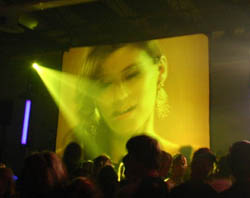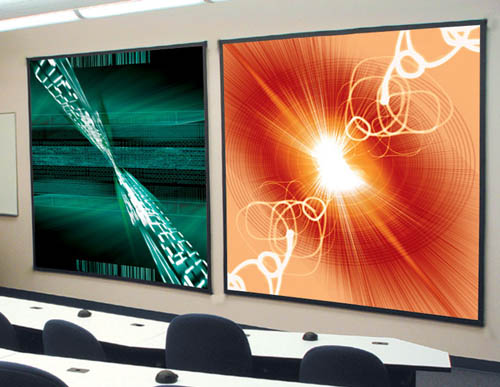
Folding screens are commonly called “Fast Folds” after the Da-Lite brand screen of the same name. This design consists of a screen frame that can be used with either front or rear fabric, and the frame can be hung or flown, or also used on the ground with a leg set.
A “dress kit” consisting of bottom, side and top drapes is often used to help control light spill as well as dress up the screen for the presentation. Common screen sizes in A/V include 6×8, 7.5×10,9×12, 10.5×14 and 12×16.
Screen placement will vary from show to show, but the basics include positioning the screen toward the center of the audience and making sure it’s high enough so that folks in the middle and toward the rear of the audience can see the entire image. For large rooms, it’s popular to use more than one screen, or even delays screens in very large space so the audience can see the presentations well.
Projectors can have many inputs. A commonly used one in A/V applications is a D-sub 15 often referred to as a Video Graphics Array or VGA input. This is the standard output on laptops and for a simple presentation a VGA cable can connect a computer directly to the projector. Other common connections include composite video, component video, RGBHV, DVI, and HDMI.
For events where multiple computers or other video sources need to share the projector, a Switcher or Scaling Switcher would be required. Passive switcher (AKA Bang Boxes) can be used when all the inputs are the same type, like computer outputs. These switchers simply choose between inputs and routes that signal to the projector.
A scaling switcher is a bit more complex. It can take inputs with different resolutions and scale or convert them to the desired output resolution. An example might be switching between a computer presentation and a video deck.
In my experience, the two main issues to deal with in projection are screen location and controlling ambient light. Screen location is important because you may need a certain distance from the screen for projector placement, especially if doing rear projection, and you want the audience to be able to see the image easily. Controlling ambient light is crucial because you don’t want stay light spill to wash out the image.
Also, projectors do not project black, which is the absence of light in the image and any stray light falling on a screen will reduce the contrast ratio, producing a perceived loss if visual quality to the audience. Place the screen where everybody can see and control the ambient light. Sounds simple enough, right?
Craig Leerman is senior contributing editor for ProSoundWeb and Live Sound International, and is the owner of Tech Works, a production company in Las Vegas.

